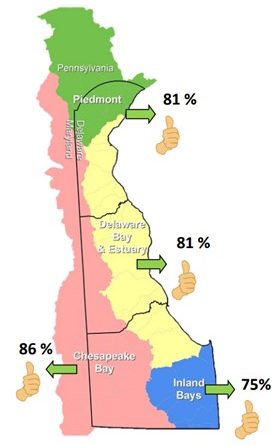The protection of groundwater resources and the area surrounding public water supply wellheads is an integral aspect of water supply assessment and protection.
The Groundwater Protection Program provides technical review of permit applications for non-hazardous waste sites (large septic, wastewater spray irrigation, sludge application) and for water well permit applications where wells are located near problem sites.
Groundwater is any water that exists under the surface. Water in the ground is most often classified by its aquifer – a layer water that is between geological formations. The aquifer that is closest to the surface is unconfined. Most domestic drinking water wells use water from this unconfined aquifer.
Staff hydrologists conduct investigations based on public complaints of groundwater quality, often associated with domestic water wells. The program oversees the Coastal Sussex Saltwater Monitoring Network and the Potomac Aquifer Saltwater Monitoring Network, which monitor sensitive coastal aquifers for saltwater intrusion.
Overall groundwater quality is evaluated annually as part of the Delaware Watershed Assessment Reports published by the DNREC Division of Watershed Stewardship.

In 1999 the U.S. EPA endorsed the Delaware Comprehensive State Groundwater Protection Program (CSGWPP) which provides a description of groundwater resource protection and assessment throughout Delaware. It also provides a framework for better focus and coordination across multiple groundwater protection programs.
Technical staff of the groundwater protection program participate in the Delaware Whole Basin Initiative to assure incorporation of groundwater resources in each of the 4 Delaware basins – Piedmont, Chesapeake, Inland Bays/Atlantic Ocean, and Delaware Bay.
In 2013, DNREC staff met to evaluate progress towards implementing recommendations that had been laid out in the Whole Basin Assessment Reports. They published a Statewide Progress Report and progress reports for each basin.
Staff hydrologists also occasionally provide presentations to educate the public and regulated community on Delaware geology, hydrology, and regulatory programs.
The Source Water Assessment and Protection Program provides for the assessment and protection of sources of public drinking water, both surface and ground water. The assessment consists of these critical steps:
The Delaware Environmental Navigator (DEN) identifies the location and status of both existing and potential sources of contamination within the State. Most potential point sources have been mapped and rated with their potential to contaminate surface water, groundwater, soil, sediment, and air.
The Delaware Wellhead Protection Plan, approved by EPA in 1990, delineated wellhead protection areas around public water supply wells and set out steps needed to protect critical wellhead areas around these wells. Some of these are handled as part of the department’s regulatory programs. Others, including Wellhead Protection Area Delineation, Contaminant Source Identification, and public participation, are part of the Source Water Assessment and Protection Program.
Related Topics: groundwater protection, groundwater resources, public water, resource protection, water supply, wellhead protection, wells